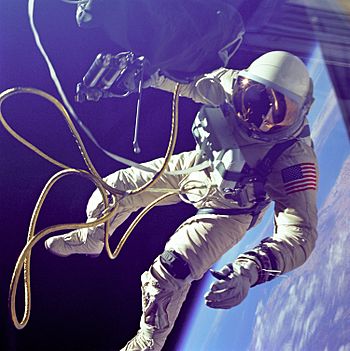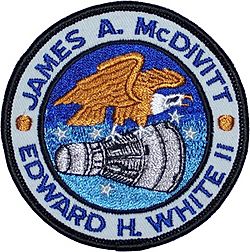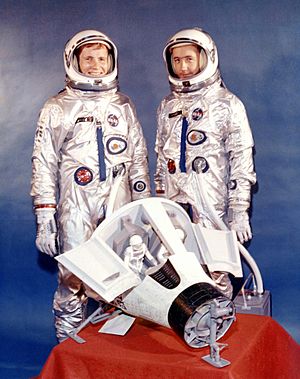Gemini 4 facts for kids

Ed White, the first American to perform extravehicular activity, outside of Gemini IV
|
|
| Operator | NASA |
|---|---|
| Mission duration | 4 days, 1 hour, 56 minutes, 12 seconds |
| Distance travelled | 2,590,600 kilometers (1,398,800 nautical miles) |
| Orbits completed | 66 (62 revolutions) |
| Spacecraft properties | |
| Spacecraft | Gemini SC4 |
| Manufacturer | McDonnell |
| Launch mass | 3,570 kilograms (7,880 lb) |
| Crew | |
| Crew size | 2 |
| Members |
|
| EVAs | 1 |
| EVA duration | 20 minutes |
| Start of mission | |
| Launch date | June 3, 1965, 15:15:59 UTC |
| Rocket | Titan II GLV, s/n 62-12559 |
| Launch site | Cape Kennedy LC-19 |
| End of mission | |
| Recovered by | USS Wasp |
| Landing date | June 7, 1965, 17:12:11 UTC |
| Landing site | North Atlantic Ocean 27°44′N 74°11′W / 27.733°N 74.183°W |
| Orbital parameters | |
| Reference system | Geocentric |
| Regime | Low Earth orbit |
| Perigee | 165 kilometers (89 nmi) |
| Apogee | 289 kilometers (156 nmi) |
| Inclination | 32.5 degrees |
| Period | 89.03 minutes |
| Epoch | June 3, 1965 |
  (L-R) White, McDivitt |
|
Gemini 4 (officially Gemini IV) was the second crewed spaceflight in NASA's Project Gemini, occurring in June 1965. It was the tenth manned American spaceflight (including two X-15 flights at altitudes exceeding 100 kilometers (54 nmi)). Astronauts James McDivitt and Ed White circled the Earth 66 times in four days, making it the first US flight to approach the five-day flight of the Soviet Vostok 5. The highlight of the mission was the first space walk by an American, during which White floated free outside the spacecraft, tethered to it, for approximately 20 minutes.
The flight also included the first attempt to make a space rendezvous as McDivitt attempted to maneuver his craft close to the Titan II upper stage which launched it into orbit, but this was not successful.
The flight was the first American flight to perform many scientific experiments in space, including use of a sextant to investigate the use of celestial navigation for lunar flight in the Apollo program.
Contents
Crew
| Position | Astronaut | |
|---|---|---|
| Command Pilot | James A. McDivitt First spaceflight |
|
| Pilot | Edward H. White II Only spaceflight |
|
Backup crew
| Position | Astronaut | |
|---|---|---|
| Command Pilot | Frank F. Borman II | |
| Pilot | James A. Lovell, Jr. | |
Support crew
- Virgil I. "Gus" Grissom (Houston CAPCOM)
- Roger B. Chaffee (CAPCOM)
- Eugene Cernan (CAPCOM)
Mission parameters
- Mass: 7,880 lb (3,570 kg)
- Perigee (insertion): 89.5 nmi (165.8 km)
- Apogee (insertion): 158.6 nmi (293.7 km)
- Period: 88.94 min
- Inclination: 32.53°
- Perigee (last orbit): 81 nmi (150 km)
- Apogee (last orbit): 125.7 nmi (232.8 km)
Spacewalk
- Ed White - EVA - June 3, 1965
- Hatch opened: 19:34 UTC
- Start EVA: 19:46 UTC
- End EVA: 20:06 UTC
- Duration: 20 minutes
- Hatch closed: 20:10 UTC
Objectives
Gemini 4 would be the first multi-day space flight by the United States, designed to show that it was possible for humans to remain in space for the length of time required to fly to the moon and back.
A second objective for the four-day, 62-orbit mission was for Gemini 4 to rendezvous and fly in formation with the spent second stage of its Titan II booster rocket.
Gemini 4 would also see the first ever American Extra-vehicular activity (EVA, known popularly as a space walk). NASA moved up the original schedule after Aleksei Leonov on Voskhod 2 the previous March performed the first EVA ever, lest the US appear to be falling behind the Soviets in the space race.
Gemini 4 would set a record for flight duration, and ease fears about the medical consequences of longer missions. It would also be the first use of the new Mission Control center outside Houston, which because of the flight's long duration, had to conduct three-shift operations.
Flight
Launch
The broadcast of the launch was itself historic. For the first time an international audience, from twelve European nations, could watch the lift off on live television via the Early Bird satellite. Press interest, due to the satellite broadcast and the new center in Houston, proved to be so high that NASA had to lease buildings to accommodate the 1,100 print and broadcast journalists that requested accreditation.
Except for a few moments of pogo (axial vibrations in the rocket), the launch itself came off perfectly, the spacecraft entering into a 163 by 282 kilometers orbit.
The rendezvous
The attempt on the first orbit at an orbital rendezvous with its spent second stage taught space flight engineers about the idiosyncrasies of orbital mechanics. The astronauts found it difficult to target the stage due to the lack of depth perception. When they fired their thrusters in the direction of the stage, they found themselves moving away and downward, as a vent opened on the stage to dump propellant caused it to move around.
After several tries to get closer and with half their thruster fuel spent, McDivitt and White finally gave up, deciding with Houston that the EVA was more important than the rendezvous, something that could be performed on later missions. (During those missions success was achieved when the chasing spacecraft first dropped to a lower, faster orbit before rising again.)
Experiments
Eleven experiments were carried on the spacecraft. Experiment D-8 was five dosimeters that measured the radiation in the spacecraft environment. Of particular interest was the South Atlantic Anomaly. Experiment D-9 was an experiment in simple spacecraft navigation where the crew used a sextant to measure their position using the stars.
Experiments 5-5 and 5-6 were both photography experiments where they used a 70-millimeter Hasselblad camera to photograph the weather and terrain below them. There were two medical experiments: M-3 and M-4. The first was a bungee cord that the crew used for exercise. They said, after the mission, that this got harder as the mission went on, though this may have been due to a lack of sleep. The second was the phonocardiogram experiment, which had sensors attached to their bodies that measured heartbeat rates, especially during liftoff, EVA, and reentry.
There were four engineering experiments. MSC-1 measured the electrostatic charge in the spacecraft, MSC-2 was a proton-electron spectrometer, MSC-3 was a tri-axis magnetometer and MSC-10 involved the crew photographing the red-blue Earth limb.
The computer failed on the 48th revolution. This was unfortunate for IBM which had just put an advertisement in the Wall Street Journal saying that its computers were so reliable that even NASA used them. The computer failure meant that the capsule would not be able to perform a lifting reentry as planned.
Reentry
Reentry came on the 62nd revolution. A rolling reentry (as used in Mercury) was chosen due to the computer failure. The astronauts began rolling the spacecraft at 120,000 meters altitude to increase its stability. They started slowing this rolling at 27,000 meters and stopped it by 12,000 meters. The drogue parachute deployed shortly after this, and the main deployed at 3,230 meters. A malfunctioning thruster caused the roll to be much faster than planned, and the landing was rough. Neither of the crew encountered any problems, however, contrary to NASA doctors' concerns about their landing upright — as opposed to on their backs, as in Mercury — after four days in space. Even though they landed 80 kilometers short of the intended landing target, some ships had already started steaming to the touchdown point and a helicopter was able to see them land.
The Gemini 4 mission was supported by the following U.S. Department of Defense resources: 10,249 personnel, 134 aircraft and 26 ships.
Insignia
Gemini 4's crew originally intended to call their spacecraft American Eagle, but this was scuttled after NASA management issued a memo saying that they did not want a repeat performance of the previous mission, on which Gus Grissom had named his spacecraft Molly Brown.
The callsign for the mission became simply Gemini 4. There was no patch flown on the crew's suits, although the one shown here, created after the fact, is on display in McDivitt's museum. Since the crew was prohibited from naming their spacecraft, they decided to put the American flag on their suits, surprisingly the first astronauts to do so, although Soviet crews used the Cyrillic "СССР" on their spacesuit helmets. Previous astronauts had only had the NASA logo and a strip with their name on their suits.
Spacecraft location
The spacecraft is on display at the National Air and Space Museum, Washington, D.C..
Images for kids
-
White (l) and McDivitt being congratulated by President Lyndon B. Johnson by telephone aboard the aircraft carrier USS Wasp
See also
 In Spanish: Gemini 4 para niños
In Spanish: Gemini 4 para niños





